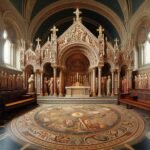Site Details:
Aldborough (Isurium Brigantia)
Isurium Brigantium was the name given to the regional hub that served as the capital of the northern part of Roman Britain in the period following the conquest of Brigantia.

The historical narrative of Isurium Brigantium, known today as Aldborough in North Yorkshire, England, suggests that it was a significant settlement before the Roman occupation. While direct archaeological evidence of a pre-Roman Brigantian settlement is lacking, the region itself shows signs of substantial activity during the period before and including the Iron Age. The presence of the Devil's Arrows, three large standing stones located a mile from Aldborough, indicates the area's historical significance.
Additionally, the Iron Age settlement of Stanwick, near Richmond, which was associated with either Cartimandua, queen of the Brigantes, or her estranged husband, Venutius, further supports the idea of notable pre-Roman habitation in the vicinity.
Isurium Brigantia
The Roman fort and town of Isurium Brigantium, which later became the administrative centre for the Romanized Brigantes, was probably founded in the late first or early second century. It is believed that the settlement began as a smaller civilian site supporting military campaigns across Yorkshire and developed into a planned town with a street grid, public buildings, and substantial fortifications by the late second century.
The strategic location of Isurium Brigantium at the intersection of Dere Street and the River Ure, along with its proximity to the Roecliffe fort, underscores its importance as a hub for accommodation, provisions, and repairs for those travelling northward. The discovery of a 1st-century pot in 2020 at the Aldborough Roman Site adds to the narrative of a thriving community at the crossroads of significant Roman roads.
A town of significant spiritual importance?
The Roman town's inception on Borough Hill, a site suggested to having been a barrow or burial mound, suggests a sacred pre-Roman importance, possibly dedicated to a local deity revered by the Brigantes tribe. The suggestion being, that the Romans, recognizing the hill's prominence, ingeniously integrated it into the urban fabric by constructing a central road that pierced through the hillock, symbolically and physically asserting their dominion while perhaps also paying homage to the site's spiritual heritage.
The later transformation of Borough Hill into a forum, the civic heart of the Roman town, further underscores the site's multifaceted importance. The forum served as a bustling public space, a marketplace, and a political hub, indicating the Romans' strategic use of the location as a centre for trade, governance, and social interaction.
St Andrew's Church
The erection of a shrine or temple, which later evolved into the church of St. Andrews, marks a continuity of sacred practice, bridging pagan and Christian worship on the same hallowed ground. This confluence of the sacred and the civic within the spatial dynamics of Isurium Brigantium reflects a nuanced Roman approach to urban planning. They often built upon existing cultural and religious landscapes, co-opting and reinterpreting them within the framework of Roman ideology and infrastructure.
The strategic placement of Isurium Brigantium on the Roman road network, at the highest navigable point on the river Ure, further highlights its significance as a vital point of communication, administration, and trade in the Roman north. The town's layout, with its regular street grid and terracing on the hillside, reveals a sophisticated level of urban design, accommodating both the practical needs of its inhabitants and the symbolic requirements of Roman and local traditions.

Aldborough Roman Town Star mosaic
The Goddess Brigantia
The Goddess Brigantia, revered in ancient times as the patron deity of the Brigantes tribe, embodies a rich tapestry of symbolic associations, particularly with water, which was often seen as a purifying, life-giving force in Celtic spirituality.
Her name is etched into the landscape itself, with the river Ure whispering echoes of her legacy, suggesting an intrinsic link between the deity, the land, and its waterways. The mention of the river, in the name Isurium, underlines that connection.
 The Lion Mosaic
The Lion Mosaic
This connection is further emphasized by the presence of numerous mosaics in Aldborough. Among these, the lion mosaic stands out, its arms extended towards a tree in a gesture that speaks volumes of the ancient culture's veneration of nature.
Such imagery is not merely decorative; it is a profound testament to the spiritual beliefs of the time, where fertility and the natural world were held in high esteem, and deities like Brigantia were invoked for their benevolent influence over these realms. The interpretation of ancient mosaics, particularly when incomplete, is a complex endeavour that requires careful consideration of historical, cultural, and religious contexts. The lion, a recurrent motif in various ancient civilizations, often symbolizes strength, royalty, and divinity.
Brigantia, a deity from Celtic (Gallo-Roman and Romano-British) religion, was revered in the region now known as Yorkshire and northern England, possibly beyond the Roman period, and there is evidence from Roman altars to suggest she may have had a very significant role within Romano-British Culture. She was considered the patron goddess of the Brigantes tribe and was associated with sovereignty, war, and prosperity. The Romans, during their occupation, often engaged in 'interpretatio Romana,' a practice of assimilating local deities with their own pantheon.
Brigantia was syncretized with Roman goddesses such as Minerva, Fortuna, and Victoria, reflecting a blend of indigenous and Roman religious practices. This syncretism extended into the Christian era, where elements of pagan worship were integrated into Christian practices, a phenomenon evident across the Roman Empire.
The potential depiction of the lion of Christ in reverence to Brigantia could suggest an early and localized form of Christian syncretism, where Christian and pre-Christian beliefs coalesced. This mosaic might represent a visual narrative that bridges the transition from pagan to Christian worship, highlighting the fluidity of religious identity in the ancient world.
What remains
Not much remains of this old capital of the north, just a couple of very intact mosaics and a vestigial perimeter wall. The remains are housed with a small museum run by English Heritage.














